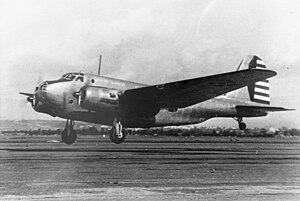North American XB-21
| XB-21 | |
|---|---|
 |
|
| Role | Medium bomber |
| National origin | United States |
| Manufacturer | North American Aviation |
| First flight | 22 December 1936 |
| Primary user | United States Army Air Corps |
| Number built | 1 |
| Unit cost |
$122,000 USD
|
The North American XB-21, also known by the manufacturer's model designation NA-21, and sometimes referred to by the name "Dragon", was a prototype bomber aircraft developed by North American Aviation in the late 1930s, for evaluation by the United States Army Air Corps. Evaluated against the Douglas B-18 Bolo, it was found to be considerably more expensive than the rival aircraft, and despite the ordering of a small number of evaluation aircraft, only the prototype was ever built.
North American Aviation's first twin-engined military aircraft, the NA-21 prototype was constructed at North American's factory in Inglewood, California, where work on the aircraft began in early 1936. The NA-21 was a mid-wing monoplane of all-metal construction, powered by two Pratt & Whitney R-2180-A Twin Hornet radial engines, which were fitted with turbosuperchargers for increased high-altitude performance.
Flown by a crew of six to eight men, the XB-21 featured a remarkably strong defensive armament for the time, including as many as five .30-calibre M1919 machine guns. These were planned to be fitted in hydraulically powered nose and dorsal turrets, in addition to manually operated weapons installed in waist and ventral positions. Up to 10,000 pounds (4,500 kg) of bombs could be carried in an internal bomb bay, with 2,200 pounds (1,000 kg) of bombs being able to be carried over a range of 1,900 miles (3,100 km).
Undertaking its maiden flight on 22 December 1936 at Mines Field, company test flying indicated a number of minor problems. Modifications resolving these resulted in the aircraft being re-designated NA-39, and, accepted by the U.S. Army Air Corps as the XB-21. The aircraft, which had been assigned the serial number 38-485, was evaluated early the following year in competition against a similar design by Douglas Aircraft, an improved version of the company's successful B-18 Bolo.
...
Wikipedia
